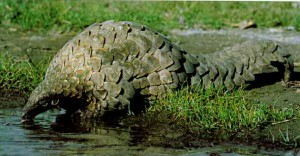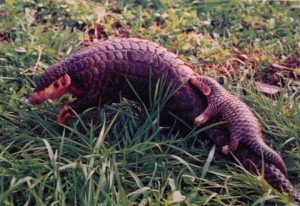All pangolins belong to the genus Manis in the family Manidae,
which is the only family within the order Pholidota.
The Asian pangolins include:
•Indian or thick-tailed pangolin, Manis
crassicaudata
 Photo:http://transcurrents.com/tc/2010/09/kaballeva_in_kandy_rare_photos.html
Photo:http://transcurrents.com/tc/2010/09/kaballeva_in_kandy_rare_photos.html
Conservation status Near Threatened
Manis crassicaudata is found in the plains and hills
of India, Sri Lanka, Nepal and some parts of Pakistan.
Its colour of its scales varies and depends on the colour
of the earth in its surroundings.
In Kerala, it is known as "Eenampechi". In Sinhala
it is called ”Kaballewa” and in Tamil ”Azhungu”
or "Alangu"
It is hunted for its meat, which is considered tasty, and
for making medicinal oil.[2]
•Chinese or Formosan pangolin, Manis
pentadactyla – Endangered
 [6]
[6]
This species occurs in the Himalayan foothills in eastern
Nepal, Bhutan and northern India, northeastern Bangladesh,
across Myanmar to northern Lao PDR and northern Viet Nam,
northern and northeastern Thailand, and through southern China
(south of the Chiangjiang) to Hainan and Taiwan.
The species is heavily hunted inside of China, and is heavily
hunted for export to China in other range states,
primarily for medicinal purposes. The populations have been
greatly reduced in the last 15 years
(generation length estimated at 5 years), and decline suspected
to continue over the next 15 years,
at a rate of over 50%.
This species is found in a wide range of habitats, including
primary and secondary tropical forests,
limestone forests, bamboo forests, grasslands and agricultural
fields, and grasslands [3]
The Chinese Pangolin belongs to the burrowing family. It can
dig up to 8 ft deep (2.5 meters) in the ground
with its strong and clawed forefeet. It just takes the pangolin
four to five minutes to dig that deep.
Once it enters the burrow, it blocks the opening. [4]
•Malayan or Sunda pangolin, Manis
javanica – Endangered
 [7]
[7]
The Sunda Pangolin, Manis javanica, also known as the Malayan
Pangolin or Javan Pangolin, is found in
South-East Asia, including Thailand, Indonesia (Java, Sumatra,
Borneo and the Lesser Sunda Islands),
the Philippines, Vietnam, Laos and Cambodia, and Malaysia
and Singapore. These pangolins are found in
Southeast Asia’s forested habitats (primarily, secondary,
scrub forest) and plantations (rubber, palm oil).
Mostly, they spend time within tree resting or searching food.
The Sunda Pangolin's main predators are the
tiger
and the
Clouded Leopard
[8]
•Palawan or Philippine
pangolin or Malintong, Manis culionensis – Near
Threatened
Manis culionensis), is a pangolin species endemic to the Palawan
province of the Philippines.
Its habitat includes primary and secondary forests as well
as surrounding grasslands. This species is moderately common
within its limited range but is at risk due to heavy hunting.
Five distinct morphological characteristics involving the
skull and the scales have been identified
which separate it from the closely related Manis javanica.[9]
The African pangolins include:
•Cape or Temminck’s ground pangolin,
Manis temminckii
 (Manis
temminckii), Madikwe Game Reserve, South Afrika [10]
(Manis
temminckii), Madikwe Game Reserve, South Afrika [10]
The Ground Pangolin (Manis temminckii), also known as Temminck's
Pangolin or the Cape Pangolin,
is one of four species of pangolin which can be found in Africa
and the only one in southern and eastern Africa.
Although it is present over quite a large area, it is rare
throughout it and notoriously difficult to spot.
Its scarcity is partly because it is hunted by humans for
its scales, which are used in love charms, and partly
because it is often burnt in bush fires.
 Ground
pangolin, Smutsia temminckii - overview
Ground
pangolin, Smutsia temminckii - overview
BBC Natural History Unit
http://www.arkive.org
The Ground Pangolin can grow to a length of about 1 metre,
with the tail typically between 30 and 50 cm.
It has a disproportionately small head, powerful hindlegs,
and small forelegs. Walking is done almost entirely
on the backlegs with the heavy dragging tail acting as a counterweight.
It is entirely terrestrial and usually found in savanna or
open woodland, generally feeding on termites or ants.
It is well adapted to this, with a very long (up to 50 cm)
sticky tongue which is stored inside a pocket in the
mouth until needed. Although it is capable of digging its
own burrow, it prefers to occupy disused holes dug
by a
Warthog or an
Aardvark
or to lie in dense vegetation, making it even more difficult
to observe. [14]
•Tree or African white-bellied
pangolin, Phataginus tricuspis – Near Threatened
Three-cusped
pangolin, Overview
http://www.arkive.org/three-cusped-pangolin/phataginus-tricuspis/video-00.html
Also known as the Three-cusped Pangolin, it is the most common
of the African forest pangolins.
The Tree Pangolin ranges from Guinea through Sierra Leone
and much of West Africa to Central Africa as
far east as extreme southwestern Kenya and north-western Tanzania.
To the south it extends to northern Angola
and north-western Zambia.
The Tree Pangolin can walk on all fours or on its hind legs
using its prehensile tail for balance.
It can climb up trees in the absence of branches. It has a
well-developed sense of smell, but, as a nocturnal
animal, it has poor eyesight. Instead of teeth it has a gizzard-like
stomach full of stones and sand it ingests.
The Tree Pangolin in Africa fills its stomach with air before
entering water to aid in buoyancy for
well-developed swimming.
 http://blog.ronandonovan.com/2011/05/tree-pangolin-%E2%80%93-kibale-national-park-uganda/
http://blog.ronandonovan.com/2011/05/tree-pangolin-%E2%80%93-kibale-national-park-uganda/
The Tree Pangolin is subject to widespread and often intensive
exploitation for bushmeat and traditional medicine,
and is by far the most common of the pangolins found in African
bushmeat markets. Conservationist believe that
this species has undergone a decline of 20-25% over the past
15 years (three pangolin generations) due mainly
to the impact of the bushmeat hunting. [11]
•Giant ground pangolin, Smutsia
gigantea – Near Threatened
 Location
captive at Johannesburg Zoo, South Africa
Location
captive at Johannesburg Zoo, South Africa
Source: flickr: Pangolin - Manis temminckii,
http://www.flickr.com/photos/wildimages/197302432/
Also called The Giant Pangolin,
Manis gigantea.
It inhabits a range stretching along the equator from west
Africa to Uganda.
It is found mainly in the savanna, rainforest, and forest,
inhabiting areas with large termite populations
and available water. The Giant Pangolin does not inhabit high-altitude
areas.
The Giant Pangolin is the
largest of all pangolin
species. While its average mass has not been measured,
one Giant Pangolin was found to weigh 33 kg (72.6 lbs). Males
are larger than females, with male body
length about 140 cm (4 feet, 7.1 inches) and female about
125 cm (4 feet, 1.2 inches).
Curiously, it also has eyelashes.
As in all pangolins, infants have soft scales that eventually
harden and are born with open eyes.
They cannot walk on their legs, but can move on their stomach.
[15]
•Long-tailed or black-bellied pangolin,
Uromanis tetradactyla
The Long-tailed Pangolin, Manis
tetradactyla, also called the Black-bellied Pangolin or ipi,
is an arboreal pangolin native to the sub-Saharan forests
of Africa. Its common name is derived from its especially
long tail
(average 60 cm, or 24 inches). In spite of the long tail,
this species is the smallest pangolin. [13]
This species occurs in the forested regions of West and Central
Africa, from Sierra Leone eastwards through
south-eastern Guinea, Liberia, Côte d’Ivoire and
south-west Ghana, there being an apparent gap in distribution
until west Nigeria. They then occur eastwards through southern
Cameroon, and much of the Congo Basin forest
block to the Semliki valley (and thus, just possibly, into
Uganda) (Kingdon and Hoffmann in press).
Their presence in Cabinda (Angola) is possible
There is no quantitative data available on densities or abundance.
This is the least frequently recorded of all
African pangolins, though it may be less rare than available
records suggest. The species is extremely shy,
almost strictly arboreal, and mainly restricted to little-known
and little-penetrated habitats [12].








 [6]
[6] [7]
[7]







